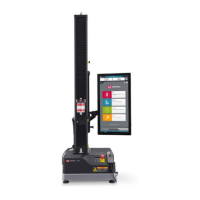89
Preload the load string
Product Support: www.instron.com
whichever is less. For example, if your grips are rated at 1kN, the load cell at 2kN and
your expected test load is 500N then you should preload to at least 550N but not more
than 1kN.
Before inserting the specimen ensure that:
• The grips and couplings are installed but the lock nuts are not tightened.
• Crosshead travel limits are set (refer to “Set the crosshead limit stops” on
page 104).
• The value of load in the live display is near zero. If it is not, balance the load (refer to
“Balance a transducer configuration” on page 105).
• The load limits are set in the software to a value that matches the maximum load
capacity of the weakest component in the load string.
1. Install the strong specimen.
2. Increase the load on the load string to the chosen preload value.
Do not attempt to increase the load by jogging the crosshead. The collision
mitigation feature will stop the crosshead before the system reaches the desired
load value.
a Start Bluehill
®
and prepare to run a test using the specifically-designed test
method, named Preload Grips. This method is located in the Templates directory
within Bluehill
®
.
b Enter values for Rate and Force and start the test.
The crosshead drives at the designated rate until it reaches the chosen preload
value and the test stops.
3. Hand tighten all the locknuts on the grips and any intermediate couplings.
4. Reduce the load to zero.
5. Remove the specimen.
The load string is now preloaded and all the locknuts are tight and should not move
during subsequent testing. The system is now ready to test.
When you next need to change grips or any other part of the load string, the locknuts will
be too tight to loosen by hand. You will need to follow the procedure “Unload the load
string” on page 90

